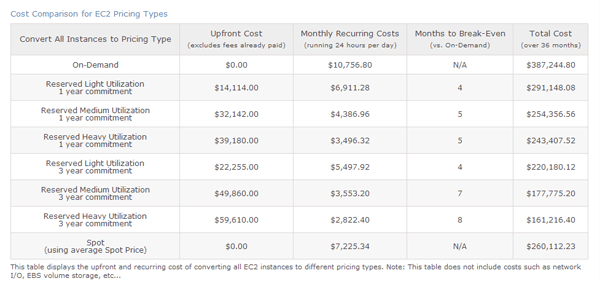We all have heard about the cost benefits of using Reserved Instances. Here at CloudCheckr, we analyze individual usage and then make actionable Reserved Instance recommendations to ensure that our customers employ optimal purchasing strategies. We also, of course, run into a fair number of folks who base purchasing decisions solely upon the AWS pricing page guidelines.
Here is an example of the guideline for Light Utilization:
The break-even point for a Light Utilization Linux RI (vs. On-Demand Instances) is 28% for a 1-year term or 11% of a 3-year term.
Amazon offers these guidelines for Medium and Heavy Reserved Instances as well:
The break-even point for a Medium Utilization Linux RI (vs. Light Utilization Reserved Instances) is 41% for a 1-year term or 19% of a 3-year term.
The break-even point for a Heavy Utilization Linux RIs (vs. Medium Utilization Reserved Instances) is 56% for a 1-year term or 35% of a 3-year term.
What we have discovered – and it is not commonly discussed – is that the break-even calculations change dramatically when using different operating systems.

For example, assuming that you are using a Standard Medium (m.1) instance in US East, the 1 and 3 year Light RI break-evens change from 28% and 11% for Linux to 33% and 13% for RHEL (Red Hat Enterprise Linux).
The change is even more pronounced if you are using Windows with SQL Standard. In this scenario, the break-even for purchase of a Light RI is 57% for 1 year and 51% for 3 years (v. 28% and 11% for Linux).
Equally interesting is the fact that the utilization/ purchase reward also breaks down. Using the Windows with SQL Standard example, the 1 year Light RI break-even is 57%, the Medium break-even is 60%, and the Heavy break-even is 62%. In comparison, the Linux break-evens are 28%, 41%, and 56%.
This indicates that the proper user question is “Reserved or not” rather than “which Reserved”.
Finally, further complicating the issue (for operating systems other than Linux) is the fact that the pricing proportionality breaks down between instance sizes. The instance prices relates, but is no longer directly proportional to the number of cores.
This means that each purchase for each size needs to be calculated individually.
All of this makes the lesson clear: before purchasing any AWS Reserved Instances, either use CloudCheckr recommendations or do your own calculations. If you do not, you may find yourself significantly overspending.
Sign up for a free, 2-week trial of CloudCheckr today and see how much you can save!
Cloud Resources Delivered
Get free cloud resources delivered to your inbox. Sign up for our newsletter.
Cloud Resources Delivered
Subscribe to our newsletter
